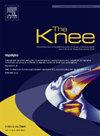全膝关节置换术后关节松弛度的评估:张紧器装置、导航和机器人评估的比较
IF 2
4区 医学
Q3 ORTHOPEDICS
引用次数: 0
摘要
背景:适当的软组织平衡对于全膝关节置换术(TKA)至关重要。目前广泛应用的评估软组织平衡的技术是利用张力装置、机器人和导航来测量关节间隙。我们比较了使用张紧器、导航和机器人工具评估的软组织平衡。方法纳入81例行双十字稳定(BCS) TKA的患者。41例采用导航(N组),40例采用机器人(R组)。最终植入后,N组采用张紧器(JLT)和导航器(JLN)测量关节松弛度,r组采用张紧器和机器人(JLR)测量关节松弛度,分别在屈曲10°、30°、60°和90°时进行评估。比较两组采用不同工具评估的关节松弛度。结果两组间各屈曲角度的jlt均无明显差异。在90°时,jlt大于jlt。在30°、60°和90°处,JLTs大于JLRs。在膝关节屈曲角度为60°时,jlt与jlr之间的差异大于jlt与JLNs之间的差异。侧室60°和90°处jlt小于JLNs。结论采用张紧器对两个隔室分别施加80 N的牵张力评估关节松弛度与机器人和导航在伸直位置评估关节松弛度相似。然而,使用张力装置评估的关节松弛度比机器人和导航在屈曲位置评估的关节松弛度大。本文章由计算机程序翻译,如有差异,请以英文原文为准。
Assessment of joint laxity following total knee arthroplasty: A comparison of tensioner device, navigation, and robot evaluation
Background
Appropriate soft-tissue balance is essential for total knee arthroplasty (TKA). Widely used techniques to evaluate soft-tissue balance are measuring the joint gap using tensioner devices, the robot and the navigation. We compared soft-tissue balance evaluated using tensioner, navigation, and robot tools.
Methods
81 patients who underwent bi-cruciate stabilized (BCS) TKA were included. 41 patients were performed using the navigation (Group N) and 40 patients were performed using the robot (Group R). After the final implantation, the joint laxities were measured using tensioner device (JLT) and navigation (JLN) in group N and measured using tensioner device and robot (JLR) in group R. The evaluations were performed at a flexion of 10°, 30°, 60° and 90°. Joint laxities evaluated by the different tools were compared in both groups.
Results
No significant between-group differences were observed for JLTs at each flexion angle in both compartments. The JLTs of were larger than JLNs at 90°. The JLTs were larger than JLRs at 30°, 60°and 90°. At a knee flexion angle of 60°, the difference between JLTs and JLRs were larger than that between JLTs and JLNs. The JLTs were smaller than JLNs at 60°and 90°in the lateral compartment.
Conclusion
Joint laxities evaluated using the tensioner device with a distraction force of 80 N for both compartments were similar to those evaluated with the robot and the navigation in extension position. However joint laxities evaluated using the tensioner device were larger than those evaluated with robot and the navigation in flexion position.
求助全文
通过发布文献求助,成功后即可免费获取论文全文。
去求助
来源期刊

Knee
医学-外科
CiteScore
3.80
自引率
5.30%
发文量
171
审稿时长
6 months
期刊介绍:
The Knee is an international journal publishing studies on the clinical treatment and fundamental biomechanical characteristics of this joint. The aim of the journal is to provide a vehicle relevant to surgeons, biomedical engineers, imaging specialists, materials scientists, rehabilitation personnel and all those with an interest in the knee.
The topics covered include, but are not limited to:
• Anatomy, physiology, morphology and biochemistry;
• Biomechanical studies;
• Advances in the development of prosthetic, orthotic and augmentation devices;
• Imaging and diagnostic techniques;
• Pathology;
• Trauma;
• Surgery;
• Rehabilitation.
 求助内容:
求助内容: 应助结果提醒方式:
应助结果提醒方式:


